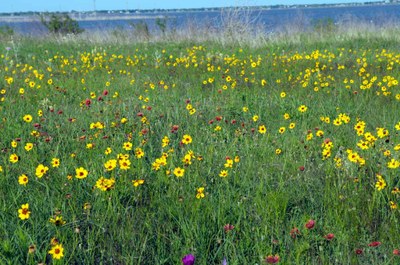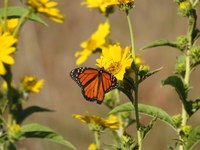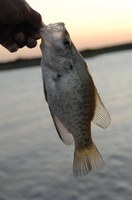Nature
Yesterday’s Prairie
 Lake Arrowhead lies at the edge of the Rolling Plains and Mesquite Plains sub-region.
Lake Arrowhead lies at the edge of the Rolling Plains and Mesquite Plains sub-region.
Native prairie
The vast prairies of central North America once sprawled from Texas to central Canada. Regular disturbances from fire and grazing bison returned nutrients to the soil, limited tree spread, and helped disperse seeds.
The rich biodiversity of these plant communities supported a staggering array of life.
Settlement
When settlers arrived on the plains, they changed the landscape. Farmers tilled the soil and planted crops. Cattle reduced grass types to all but a few species that could withstand their constant grazing. These practices destroyed a delicate balance, resulting in the loss of much native prairie habitat in Texas.
Today’s Prairie
Restoration

- Monarch butterfly
We use prescribed burns to restore the natural prairie cycle in the park. Careful removal of non-native and invasive species helps grasses and wildflowers flourish.
As these native plants return, Texas pollinators such as bees, bats and hummingbirds return, as well. You can now enjoy bursts of prairie color in the spring.
Wildlife and humans benefit from the restoration of these valuable prairie landscapes.
Wildlife & wild plants
Pocket prairies provide refuge to native grasses and wildflowers, including Texas bluebonnet, Indian blanket, Texas Indian paintbrush, Maximilian sunflowers, Texas blazing star, pink evening primrose and milkweed.
Popular fish include crappie, perch, catfish and bass. Learn more:
- Detailed fishing and lake information for Lake Arrowhead
- Lake Arrowhead State Park Fishing Tip Sheet
You may see white-tailed deer, coyote, bobcat, skunks and armadillos in the park. Monarch butterflies pass through during migration in spring and fall.
Birding

- Painted bunting
Waterfowl and wading birds are common park visitors and residents. Depending on the time of year, you may see or hear these species: painted buntings, bald eagles, osprey, bluebirds, belted kingfishers, American white pelicans, scissor-tailed flycatchers, and, very rarely, long-eared owls. Migrating species may fly over or stop briefly.
Download Birds of Lake Arrowhead SP: A Field Checklist | PDF. Save on your device or in the cloud and check off species as you see them.

